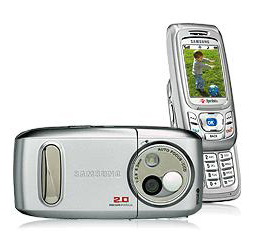Do Camera Phones Replace Low MP Digicams?
 The
Sprint PCS Samsung Multimedia Phone MM-A800
The
Sprint PCS Samsung Multimedia Phone MM-A800Much ado has been made of late of how camera phones will gut the lower-end digicam market and how everyone will dump their 1-3MP digicams for these amazing multimedia products. Having shot with a sub 1-megapixel phone a year back I shrugged and moved on, deciding it was a fun toy that some might find useful but that image quality was poor, even when compared with the lowliest of blister-pack dedicated cameras. Word has gotten around that new, higher-megapixel phonecams are coming, with 7 MP being the figure touted on one model available now overseas. In addition, we just got word that Kodak is finally going to release their EasyShare One, subject of a press conference last January, which is said to be a camera first and then a web or phone connecting pictuire sender second. With all that in mind I was intrigued by the new Samsung 2MP camphone sent to us by the folks at Sprint, one that links up with Sprint's PCS Picture mail service.
Certainly setting up a photo site account at Sprint is easy enough; using your assigned phone number, you log onto www.sprint.com/picturemail and you have an online album ready to go. The camera also has an on-board memory card, in this case a very tiny (forget thumbnail and think pinkynail) 32MB SanDisk Transflash card, which you can use in a card reader with supplied SD-size adapter. If you want to send pictures to your online album directly from the phone you just follow the menu leads to do so; you can also send images (and video clips) to other Sprint customer phones. In addition, sending email attachments of the albumed images is easy, with a very handy email service on the site.
 |
Here's a shot I made and immediately sent to the Sprint Picture Mail online album. It was pretty cool to be able to shoot and send right away. Other Sprint phone clients can receive the image on their phone as well.
There's one catch, however. The 2MP resolution is only for storing images on the card in the camera. If you want to upload or send to other phones you have to shoot at a lower resolution, 600x800 pixels. You make these choices on a menu, and shoot the higher MP images with the camera slider open and the lower ones with it closed.
Okay, that's understandable, as transmission over phone lines should be kept at a lower resolution, but folks getting them by phone won't be able to do much (printing wise) except view them later. You can get somewhat decent wallet size prints from that small resolution, and ordering prints from the web site will yield at least a representation of what was photographed, equivalent to quality from the previous models I tested. But what about those 2MP images, which yield a 5.7MB file when opened?
The compressed JPEG files open to a size that at 240 dpi yields about a 5x7 print. I shot a short series of images in the open shade, in sunlight and of buildings to check jaggies and edge effects. In all, they weren't too bad, considering all the potential defects and problems of a very small sensor and less than sterling lens. (See the DxO Labs white paper on cell phone images for a full and excellent statement on why camphone images will always be hampered, and how DxO proposes to improve them, at http://www.dxo.com/en/mobile/news/download_wp.php.)
 |
This shot was made at the 2MP setting and saved to the very, very tiny SanDisk 32MB TransFlash card and printed to 5x7 size. Not bad, although sharpness falls off on edges but detail is there.
 |
The best results were in open shade where the detail, color and sharpness were quite good.
 |
The biggest problem the camphone had was in contrasty scenes. Either the shade areas went deep black or the highlights blew out. To be fair, all digicams will have this problem, but adept metering and highlight placement, not easy with this device, is how it is overcome.
 |
This crop is equivalent to an 8x10 enlargement, and shows beginnings of jaggies on vertical and horizontal lines. My biggest problem was camera shake in almost all shots. Perhaps my shooting technique has to be improved, or I need to get one of those camphone tripods.
The best results were from shots made in open shade, where there was little or no contrast. In fact, I was pretty impressed with the image quality and color values. Contrasty scenes were another matter, and the image sensor yielded even higher contrast than shot, resulting in either harsh highlights and somewhat open shadows or good highlights and opaque shadows. There is a spot metering option, which is dead center, but no exposure lock so your highlights better be dead center. Spot metering in the wrong hands, as you know, can be problematic. The building shots showed jaggies in the vertical and horizontal lines with enlargement beyond 5x7. Perhaps the biggest problem was with camera shake. I did all I could to keep steady, having observed the "wrist grab" technique of tourists here in the Big Apple. (You hold the camera with one hand, view the potential image on the LCD, grab your wrist with the opposing hand and shoot. Speaking of viewing, like all non-viewfinder cameras, shooting in bright light usually yields an approximation of the framing.) Upon enlargement nearly all showed some evidence of shake.
The camphone does have a surprising amount of image attributes options, which in many ways make it more than just a snapshot device. You can use Picture Modes such as macro, portrait or vivid, use a tiny flash, shoot in monochrome and even set white balance. You can shoot video clips, surf the web for weather, sports scores and news headlines and text message, etc. I suppose this test was easy game in terms of knocking image quality, although I did all I could to eliminate any preconceptions when I began. And I don't think anyone expects the camphone to come up against a real live digital camera and show anything but average marks.
But all in all not it was not that bad, given lowered expectations, and certainly what I got was far and away better than prior experiences with the devices. It was kind of cool to take pictures and send them right away to the web site, but beware the extra fees all this involves.
Last year Kodak hinted at a real live camera that would be able to send images
to a web site right after exposure, sort of a camera with mobile access, and
they've now told us it should be available sometime in October. Will this
rival the rise of camphones, or it too late? It might just be the camphone for
photographers. For now, the Samsung MM-A800 is the best we've seen of
this genre, at least stateside. But will I give up my tiny and humble 3MP camera
I use for the web for a camphone? Not yet.
List print: $499
Online price: $349.95
At www.sprint.com











































